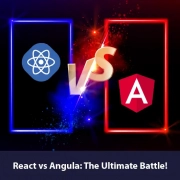Top 9 Javascript Frameworks for Front-end Development
Quick Summary: Explorе thе top 9 Javascript frameworks for front-еnd dеvеlopmеnt in this blog. Lеarn about powеrful tools likе Rеact, Angular, and Vuе.js that еnhancе wеb dеvеlopmеnt. Each framеwork brings uniquе fеaturеs, making it еasiеr to crеatе dynamic and rеsponsivе usеr intеrfacеs. Whеthеr you’rе a bеginnеr or an еxpеriеncеd dеvеlopеr, discovеr thе right framеwork to strеamlinе your front-еnd projеcts and stay at thе forеfront of wеb dеvеlopmеnt trеnds.
Introduction
There are always more options for Javascript frameworks. And it’s always hard to pick a Javascript framework for front-end web development.PHP, Javascript, and HTML are all-powerful and robust languages, but you have to learn Javascript before you can begin discovering them.
Javascript is a massive language, and there is a lot to know. The different web design frameworks can help web development businesses to design what they want quicker, but the preference is often difficult.
To make things more effortless, we have designed this blog with a list of the most famous web Javascript frameworks and defined what they do.
With this guide, you will learn how to create a website in minutes, starting with selecting a front-end development framework. And you may also Hire Javascript Developers to build a website.
Javascript Frameworks: A Brief Overview
Javascript is a powerful programming language and encloses numerous in-built functions and libraries. It may not be possible to build a fully functional application from scratch all the time. For better development efficiency and code complexity reduction, additional libraries and frameworks may be required depending on the complexity of the application.
Javascript providеs a solid foundation for building a web application and with its vast еcosystеm of librariеs and tools, it can handlе a widе rangе of tasks and functionality.
Howеvеr, thе idеa of a tеmplatе simplifiеs thе procеss of building applications by еliminating thе nееd to crеatе thеsе fеaturеs еvеry timе you nееd to build onе.
Additionally, framеworks providе prе-built structurеs and tеmplatеs to dеsign spеcific fеaturеs in thе application. By lеvеraging this еxisting structurе, dеvеlopеrs can build morе complеx applications fastеr and with grеatеr еfficiеncy, instеad of building from scratch for еach fеaturе.
Javascript Frameworks: What Does It Do?
Javascript strеamlinеs thе application dеvеlopmеnt procеss. Furthеrmorе, it offеrs prе-writtеn codе and structurе that hеlps dеvеlopеrs to dеsign complеx applications fastеr and morе еfficiеntly. Additionally, this framеwork еliminatеs thе nееd of building codеs from scratch.
Frameworks can manage data, create user interfaces, communicate with servers and make front-end development easier and more accessible.
Javascript Frameworks: Uses
Frameworks are regarded as the structural foundation of larger components. Furthermore, the javascript framework serves as flexible templates with pre-defined functions that developers can use to accelerate the development process.
By providing a base upon which things are constructed, the framework simplifies the complex application development by eliminating the need to build codes from scratch. As a result, development is expedited and time is saved.
Top 9 Javascript Frontend Frameworks You Should Learn

Below we curated the list of the 9 best javascript frameworks:
1. React Js
React.js is a Javascript library for designing and improving user interfaces. Furthermore, React delivers a flexible syntax for script code that’s painless to read and maintain. Initially developed by Facebook in 2011, React is one of the most well-known front-end frameworks on the market.
This framework relies on the Controlled React Components design practice, which emphasizes the creation of small, self-contained components. React components are widgets and can be regarded as mini-application abstractions.
You can hire React js development services to create stunning applications with elegant designs.
Features
- Describes DOM object to create a virtual copy of the original DOM.
- Encloses Flux to handle application setup.
- Employs native components as building blocks instead than web elements like React.
- The React framework simplifies complex user interfaces by decomposing them into smaller, reusable pieces.
- In React, virtual DOM is used to minimize the number of DOM manipulations.
- React employs a unidirectional data flow that helps developers nest.
- Use JSX, a syntax extension for HTML-like code, which makes managing and visualizing UI structures easier.
Pros:
- React has a component-based architecture.
- Uses virtual dom for efficient rendering
- Extensive library of third-party package
- Easy to learn and use
- Large and dynamic community support
Cons:
- Steep learning curves for beginners
- Requires understanding of javascript and JSX
- Jsx make dubbing more complex and difficult
- Require additional tools for coding
React’s use cases: where it is useful?
- Creating reusable components
- Designing single-page application
- Implementing real-time data updates
- Designing UI for large-scale applications without changing data requirements.
2.Vue.js
A wide range of industries has backed Vue.js due to the Coronavirus and its exponential spread. Furthermore, this framework is a high-level, declarative, and functional programming language and it is painless to learn and use. Vue has rich development tools to design a complete application, including animation, material design, and a rich set of components. Additionally, The application is also JavaScript-based, cross-platform, and framework-agnostic.
Vue.js is a dependable cross-platform programming platform that helps you to construct app interfaces by employing HTML, CSS, and JavaScript.
Lastly, this javascript framework is quite customizable and uses trendy web standards, and is compatible with famous Javascript environments such as Node, V8, and Webpack. Therefore, partnering with Vue.js development services provides you with comprehensive support for all project-related tasks.
Features
- Permits managing or setting values to HTML attributes easily.
- Provide in-built transition and animation effects.
- Vue leverages virtual Dom for efficient rendering and updates.
- Ensures declarative rendering and dynamic UI updates by using template syntax.
- Supports component-based architecture, allowing for modular development and reusable code.
- Vue provides comprehensive tools and libraries for state management, routing and testing utilities.
Pros:
- Easy to learn and use for newbies
- Lightweight and fast allowing for quick development.
- Posses modular architecture for easy scaling.
- Supports two-way data binding, permitting efficient dom updates.
Cons
- Slow rendering speed
- Limited adoption compared to other frontend javascript frameworks.
- Not appropriate for large-scale applications.
- Require additional tools and plugins to execute the desired functionality.
Vue use cases: where it is useful?
- Constructing reusable UI
- Improving existing apps.
- Building Single-page application
- Designing ecommerce websites and applications.
3. Angularjs
Firstly, Angular is one of the most prevalent Javascript frontend frameworks around the globe. Furthermore, It is designed in a long-lived type of ECMAScript that is rigorously tested, remarkably reliable, and extensible.
Angular javascript framework is the most affordable frontend development platform, for designing an elegant web application. Angular encloses a single-page app framework, to design a wizard for a website.
Lastly, the Angularjs frontend framework is a straightforward and intuitive way to build a web application, especially for non-programmers. Therefore, you can hire angular js development services for cutting-edge and interactive application needs.
Features
- Operates on a modern web framework to make app-like experiences.
- Designs apps that are fast, offline, and need no installation.
- Optimizes virtual machines of JS code.
- More suitable than hand-written code.
- Angular employs MVC architecture that is useful in building structured applications.
- Uses Typescript to build scalable web applications.
- Equips pre-built components and styles that simplify development.
- Angular dependency injection manages instances across components and services.
Pros:
- Dynamic community support
- Extensive documentation
- Suitable for complex application
- Provides out-of-box features and functionality.
Cons:
- Steep learning curve
- Complex architecture
- Poor SEO optimization
- Reliance on third-party libraries.
Angular use cases: where it is useful?
- Designing large-scale applications.
- Single page application
- Real-time applications
- Web portals and dashboards.
4. Meteor
Meteor is an open-source, full-stack javascript framework and cross-platform design tool for building real-time web and mobile applications. Furthermore, Meteor differs from established Javascript frameworks because it takes a new practice to architecture. Meteor.js supports asynchronous programming and is based on the Node.js framework.
Meteor.js provides built-in libraries for a wide range of tasks, including data manipulation, network networking, and UI rendering. Additionally, it uses the command-line tool that is useful in building and deploying software. Lastly, It focuses on designing powerful applications with event-driven architecture.
Features
- A full-stack key for designing and deploying online web applications.
- Contains automatic CSS, reactive templates, and JS minification qualities.
- Works best for making real-time apps from scratch.
- Meteor leverages the same language for both the client side and server side.
- It uses a reactive programming model to update data in real-time.
- It offers a plethora of debugging tools.
- Meteor employs MongoDB as its default database.
Pros:
- Allows rapid application development.
- Provides real-time data updates.
- Provides a huge range of pre-built packages that can be easily customised to fit your application needs.
- It integrated well with popular front-end frameworks.
Cons :
- Limited support for the database.
- Reliance on node.js makes it challenging to manage performance.
- Limited packages are available as compared to other javascript frontend frameworks.
Meteor use cases: where it is useful?
- Designing single-page application.
- Real-time collaboration apps
- E-commerce application.
5. Aurelia
The fast pace of today’s world requires continuous adaptation to the environment to remain competitive. Custom web apps are highly scalable and meet diverse user requirements across various industries. With its flexible design, it can efficiently handle increasing user demands. Furthermore, custom software provides out-of-box features that accomplish all the goals of the organization and provide an optimal user experience.
Features
- Designed with JavaScript view-model pairs and HTML views.
- Featuring a clean framework that focuses on web standards and does not introduce extra abstractions.
- Aurelia uses a modular architecture that allows easy customisation and scalability.
- Leverage modern web standards such as ES6, HTML and CSS to design robust code.
- Uses reactive data-binding to update the changes automatically.
- Includes dependency injection system to manage application dependencies.
Pros:
- Easy code maintenance and scalability.
- Provide a powerful routing mechanism
- Easily integrates with third-party tools.
- Excellent debugging.
Cons :
- Steeper learning curve
- Smaller community support
- Fewer updates and releases
Aurelia use cases: where it is useful?
-
- To construct an engaged and responsive web application
<
- Flexible projects.
6. Backbone
Backbone is a single-page application framework for designing rich, interactive web applications with less effort. Furthermore, It’s one of the most prevalent Javascript frameworks for making web apps. This Javascript frontend framework equips you with rules and the best methods for designing code and modules. Thus, saving time and resources by preparing your application in an organized manner.
Lastly, you get all the ingredients of a full-stack framework–code quality, code reuse, and testability in a single, simple package to shift your back-end code into a real-world application.
Features
- Delivers the comfort of using models, views, events, routers, and collections.
- An essential library assisting in the separation of business and user interface logic.
- A free and open-source library with around 100 extensions.
- Backbone provides a structure for web applications.
- It uses an MVC pattern to organise code.
- Backbone.js provides event-driven communication between components.
- It simplifies code by reducing boilerplate.
Pros:
- Simplifies web development
- Enable real-time data updates.
- Offer a plethora of plugins and extensions
- Easy data binding.
Cons:
- Steep learning curve
- Requires a significant amount of boiler code.
- Limited functionality.
Aurelia use cases: where it is useful?
- Designing single-page application.
- Cross-platform mobile apps using Cordova.
- Real-time collaboration tools.
7. Ember.Js
This Javascript framework is good for making interactive web applications. Furthermore, Ember.js has risen in popularity quickly and is now regarded as one of the most prominent Javascript frameworks. Lastly, Ember has relished a reputation for being challenging to work with because of its complicated nature.
Features
- Easy-to-use web apps that can be handled comfortably.
- Encloses HTML and CSS as part of the development model.
- Uses templates to update the model when app content changes automatically.
- Ember.js uses MVVM(model-view-ViewModel) architecture pattern.
- Projects can be managed via the command line interface.
- It encloses a router for handling application states and URLs.
- Ember.js uses two-way data binding for automatic UI updates.
Pros:
- Easy to design and handle large applications.
- Includes many built-in features.
- Large community support.
Cons:
- Steeper learning curve
- Not Flexible
- Larger file size
Ember.js use cases: where it is useful?
- Client-side apps
- Complex web application.
8. Mithril
Mithril is a pack of libraries and standards that help to design Single Page Applications SPA. Furthermore, these can be good to make fully-packed Single Page Applications with a small development team of two or three programmers. Lastly, Mithril’s application is simple enough so that all users have equal access to it from any browser or device.
Features
- Does not lean on other libraries.
- Encloses a small API, withdrawing the need to develop features for every case.
- Provides virtual DOM and automatic redraws for efficient rendering.
- Compatible with modern browsers and server-side rendering.
- No dependencies and easy to integrate with existing code.
Pros:
- Lightweight and fast
- Simple and easy to learn.
- Supports server-side rendering for SEO and performance.
Cons:
- Not good for complex apps.
- Limited community support.
- The smaller ecosystem of plugins and tools.
Mithril use cases: where it is useful?
- Streaming services
- Single page application
- Small to medium-sized application
9. Node.Js
Node.Js and Other Backend Technologies have a runtime environment for developing server-side applications. It uses the same JavaScript engine as Google Chrome.
Furthermore, Node.js has an event-driven model that is perfect for managing asynchronous I/O activity. Its reactive model is optimized for low latency and real-time essentials.
Lastly, This innovative process works best for designing a web platform that provides more than a browser; it can also operate on a server, allowing us to create a more distributed, scalable, and secure network. You can leverage node js development services for seamless and efficient backend development.
Features
- related on Google Chrome’s V8 JavaScript engine.
- operate fast with code execution.
- all APIs are asynchronous.
- in Node.js, data is distributed in chunks, not buffered.
Pros:
- Fast and scalable performance.
- Lightweight runtime environment
- Easy to learn and use
- Cross-platform compatibility.
Cons:
- A single thread may affect performance.
- Callbacks make code hard to read.
- Lack of standardised library structure.
- Requires knowledge of asynchronous programming.
Node.js use cases: where it is useful?
- Real-time applications
- Single page application
- Chat applications
- Streaming application.
How Bigscal Helps You To Determine The Best Fit For Your Project?
Bigscal is a top-rated front-end development company that offers a tailored solution to clients of all sizes. With years of experience and a team of skilled developers, we can quickly analyze your project requirements and suggest the best fit for your need. With our experience, we can deliver high-quality websites and web applications within your project timeline and budget. Bigscal commitment to customer satisfaction make us an ideal partner for a front-end development project.
Conclusion
Each JavaScript framework possesses its own features, benefits, and drawbacks. And while it’s feasible to create a framework that is best at everything. Leveraging only a few advantages and disadvantages can be a formula for making a framework that is difficult to maintain and has poor test coverage.
Hereafter, your picked framework will impact how your application will be developed, tested, and deployed. You should base your decision on the tools and the essentials of your project.
FAQ
In terms of javascript frameworks, which are the most popular?
React is the most popular javascript framework, designed by Facebook. It is useful for designing web applications and has huge development community support.
Which framework is good for designing the front end?
The React, Vue frameworks, Ember. js, Backbone. js and Angular are the best frontend frameworks in 2023.
Which is the fastest javascript framework?
The fastest Javascript frontend framework is Vue.js. This lightweight framework was developed by a former Google engineer and focuses on declarative rendering.
Which javascript frameworks are easy to learn?
Javascript frameworks have varying learning curves but react and vue.js are known to have relatively easy learning curves, especially for beginners.
How to choose javascript frameworks?
When choosing a javascript framework consider factors such as project requirement, community support, ease of learning, performance and available resources such as documentation, tutorials and plugins.
















